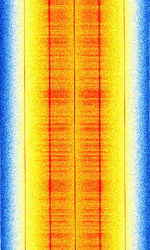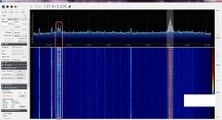NOAA Direct Sounder Broadcast (DSB)
 | |
|---|---|
| Frequencies | 137.35 MHz,137.77 MHz |
| Frequency Range | 137.35 MHz - 137.77 MHz |
| Mode | NFM |
| Modulation | PSK |
| ACF | — |
| Emission Designator | — |
| Bandwidth | 33.5 kHz |
| Location | Worldwide |
| Short Description | The Direct Sounder Broadcast (DSB) is an auxiliary telemetry downlink from NOAA Polar Operational Environmental Satellites (POES), transmitted alongside Automatic Picture Transmission (APT) broadcasts. |
| I/Q Raw Recording | Download file |
| Audio Sample | |
The Direct Sounder Broadcast (DSBDual Side Band Modulation) is an auxiliary telemetry downlink from NOAA Polar Operational Environmental Satellites (POES), transmitted alongside Automatic Picture Transmission (APT) broadcasts. DSBDual Side Band Modulation in this context is not to be confused with Dual Side Band modulation. On August 19th 2025, the final satellite transmitting this mode (NOAA-15) was decommissioned at 15:26 UTC right before APT was shutdown shortly after. This mode is no longer in use.
Characteristics[edit]
The DSBDual Side Band Modulation telemetry sends scientific and debugging data from the onboard TIROS Information Processor onboard NOAA weather satellites. The telemetry data contains information and measurements from the following onboard devices:
- The HIRS/3 and HIRS/4 instruments which is a high resolution infrared sounder which can be used to create a low resolution multi-spectral scan of the earth. (more info)
- The Space Environment Monitor (SEM-2) which has a Medium Energy Proton and Electron Detector (MEPED), and a Total Energy Detector (TED). This experiment is used to measure the effect of the sun on satellite communications. (more info)
- The experimental DCS/2 transmitter which retransmits signals from 401.65 MHzMegaHertz (MHz) 10^6 Hz sea buoys, arctic fox collars, sea ice monitors, weather balloons and more. (more info pdf)
- The ARGOS Advanced Data Collection System (ADCS) which amongst other uses is used in research for tracking animal GPS collars around the world.
The telemetry signal itself is a Dual side band-modulated PSKPhase-Shift Keying signal spanning about 33.5 kHzKiloHertz (kHz) 10^3 Hz.
- The DSBDual Side Band Modulation uses PSKPhase-Shift Keying with -67/+67 degree modulation index.
- Transmitter Power (EOL) 1.0 watts (30dBm)
- Radiated Power (dBm) .5 (over 90% of sphere)
- Signal is linearly polarized
Samples[edit]
DSBDual Side Band Modulation Sample, NFMNarrowband Frequency Modulation DemodulatedDSBDual Side Band Modulation Sample, USBUpper Side Band Modulation (Radio, referring to reception and modulation mode)Universal Serial Bus (Computer, referring to USB Ports and cables) Left Sideband Demodulate
Frequencies[edit]
NOAA use 137.35 MHzMegaHertz (MHz) 10^6 Hz and 137.77 MHzMegaHertz (MHz) 10^6 Hz for telemetry data.
Decoding Software[edit]
Decoding Tutorials[edit]
Decoding the NOAA Weather Satellite Telemetry Beacons
Additional Links[edit]
- NOAA POES TIP Demodulation nebarinx wiki log
- NASA Characteristics of a Split-Phase Telecommunications Link
- NOAA Documentation on DSC (pg. 57)
Additional Images[edit]
|
|
